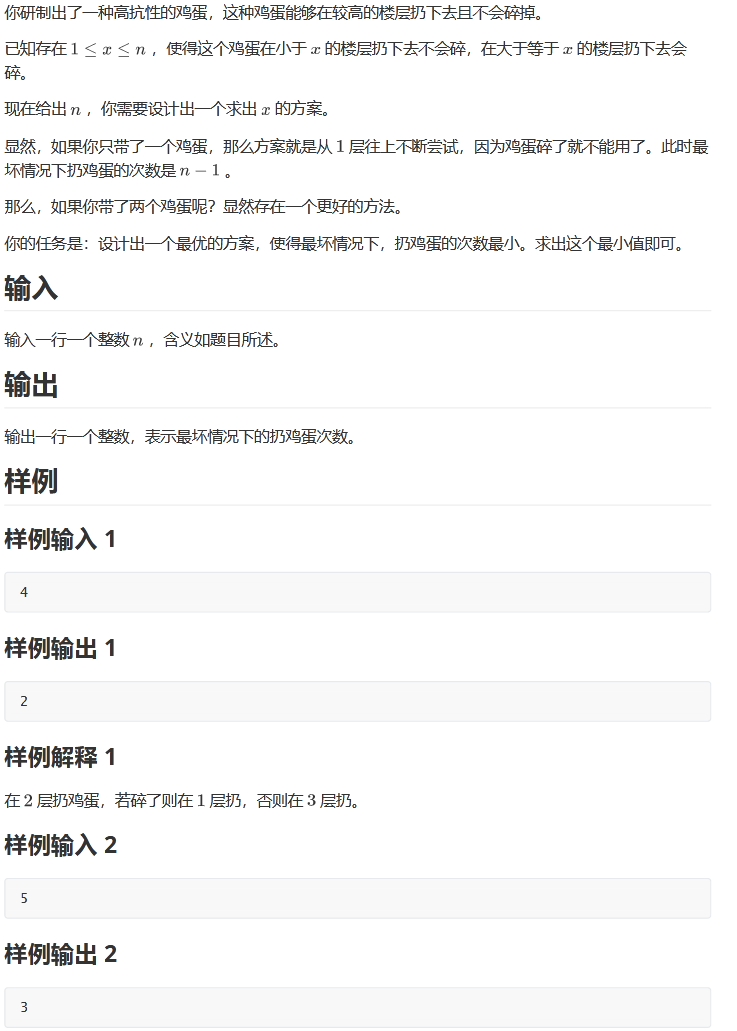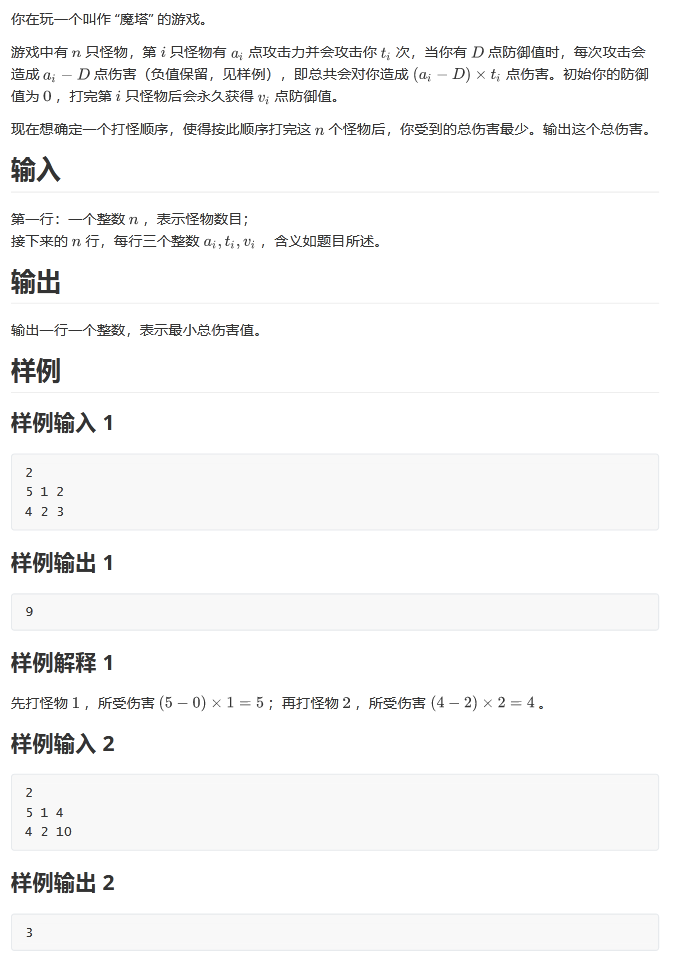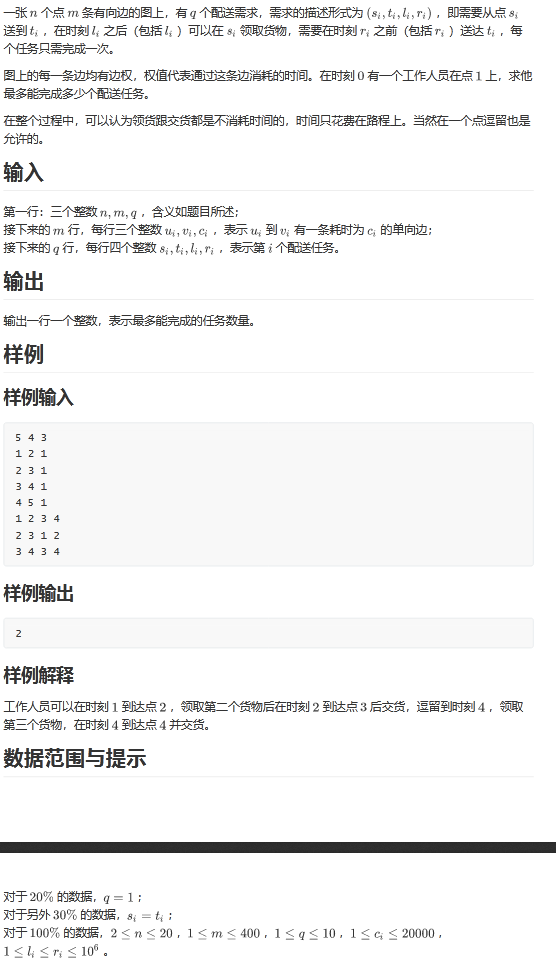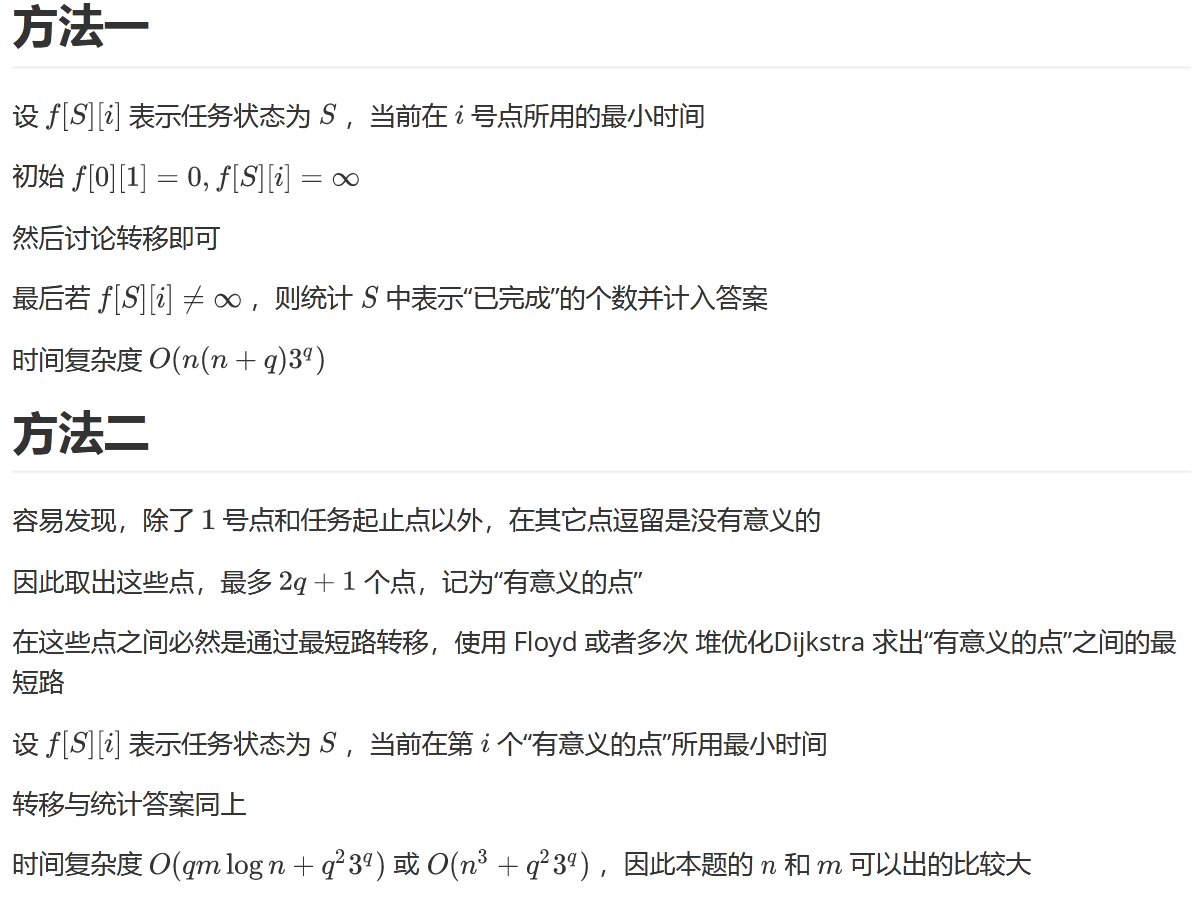8.3集训
上午
第一题

其中\(n \leq 1e18\)
#include <bits/stdc++.h>
#define int long long
#define debug
using namespace std;
const int N = 1e5+66;
int n;
inline int thestars() {
cin >> n;
int l = 1, r = sqrt(n)*2+1;
int mo = 2*n-2;
while (l < r) {
int mid = (l + r)>>1;
if (mid*(mid+1) >= mo) r = mid;
else l = mid+1;
}
cout << l;
return 0;
}
int youngore = thestars();
signed main() {;}
第二题


有百分之二十的暴力,但是需要LL
#include <bits/stdc++.h>
#define int long long
#define debug
using namespace std;
inline long long read() {
long long s = 0, f = 1; char ch;
while(!isdigit(ch = getchar())) (ch == '-') && (f = -f);
for(s = ch ^ 48;isdigit(ch = getchar()); s = (s << 1) + (s << 3) + (ch ^ 48));
return s * f;
}
const int N = 3e5+66, INF = 214748364000000;
int n, res = INF;
int vis[N];
struct node{int a, t, v;}yhm[N];
inline void dfs(int x, int num, int ans, int fangyu) {
vis[x] = 1;
if (num == n) {
res = min(res, ans);
return;
}
for (int i = 1; i <= n; ++ i) {
if (!vis[i]) {
int now_ans = (yhm[i].a-fangyu)*yhm[i].t+ans;
int now_fangyu = yhm[i].v + fangyu;
dfs(i, num+1, now_ans, now_fangyu);
vis[i] = 0;
}
}
}
inline int thestars() {
n = read();
for (int i = 1; i <= n; ++ i)
yhm[i].a = read(), yhm[i].t = read(), yhm[i].v = read();
for (int i = 1; i <= n; ++ i) {
memset (vis, 0, sizeof vis);
dfs(i, 1, yhm[i].a*yhm[i].t, yhm[i].v);
}
cout << res;
return 0;
}
int youngore = thestars();
signed main() {;}
下面给出正解:

#include <bits/stdc++.h>
#define int long long
#define debug
using namespace std;
inline long long read() {
long long s = 0, f = 1; char ch;
while(!isdigit(ch = getchar())) (ch == '-') && (f = -f);
for(s = ch ^ 48;isdigit(ch = getchar()); s = (s << 1) + (s << 3) + (ch ^ 48));
return s * f;
}
const int N = 4e5+66;
int n, res, fangyu;
struct node {int a, t, v; double anzhi;}yhm[N];
inline int cmp(node x, node y){return x.anzhi > y.anzhi;}
inline int thestars() {
cin >> n;
for (int i = 1; i <= n; ++ i) {
yhm[i].a = read(), yhm[i].t = read(), yhm[i].v = read();
yhm[i].anzhi = (double)yhm[i].v/yhm[i].t;
}
sort (yhm+1, yhm+n+1, cmp);
for (int i = 1; i <= n; ++ i) {
res += (yhm[i].a - fangyu)*yhm[i].t;
fangyu += yhm[i].v;
}
cout << res;
return 0;
}
int youngore = thestars();
signed main() {;}
第三题


我的代码:
#include <bits/stdc++.h>
#define LL long long
// #define debug
using namespace std;
const int N = 25;
int n, m, q, res;
int ql[N], qr[N], qs[N], qt[N], base[N];
int dis[N][N], f[600000][N];
inline void shuru() {
cin >> n >> m >> q;
memset(dis, 0x3f, sizeof dis);
for (int i = 1; i <= n; ++ i) dis[i][i] = 0;
for (int i = 1; i <= m; ++ i) {
int u, v, w;
cin >> u >> v >> w;
dis[u][v] = min(dis[u][v], w);
}
for (int k = 1; k <= n; ++ k)
for (int i = 1; i <= n; ++ i)
for (int j = 1; j <= n; ++ j)
dis[i][j] = min(dis[i][k]+dis[k][j], dis[i][j]);
base[0] = 1;
for (int i = 1; i <= q; ++ i) {
cin >> qs[i] >> qt[i] >> ql[i] >> qr[i];
base[i] = base[i - 1]*3;
}
memset(f, 0x3f, sizeof f); f[0][1] = 0;
}
inline void jiejue() {
for (int i = 1; i < base[q]; ++ i) {
for (int j = 1; j <= n; ++ j) {
for (int k = 1; k <= q; ++ k) {
if (i%base[k]/base[k - 1] == 1)//qu chu
f[i][qs[k]] = min(f[i][qs[k]],max((f[i - base[k - 1]][j] + dis[j][qs[k]]), ql[k]));
else if (i%base[k]/base[k - 1] == 2 &&f[i - base[k - 1]][j] + dis[j][qt[k]] <= qr[k])
f[i][qt[k]] = min(f[i][qt[k]],f[i - base[k - 1]][j] + dis[j][qt[k]]);
}
}
}
}
inline void shuchu() {
for (int i = 0; i < base[q]; ++ i) {
for (int j = 1; j <= n; ++ j) {
if (f[i][j] != 0x3f3f3f3f) {
int now(0);
for (int k = 1; k <= q; ++ k)
if (i%base[k]/base[k - 1] == 2)
++ now;
res = max(res, now);
}
}
}
cout << res;
}
inline int thestars() {
shuru();
jiejue();
shuchu();
return 0;
}
int youngore = thestars();
signed main() {;}
下午
rqj学长讲课
二分
我从来只写一种二分:
二分
while (l < r) {
int mid = (l+r+1)>>1;
if (a[mid] >= x) r = mid - 1;
else l = mid;
}
二分有好多种写法,李某东dalao说,只有百分之十的程序员能写对二分。。。
二分查找:在一个从小到大的序列中balabala...
考虑:为什么一定是从小到大?因为二分无论是查找还是二分答案都必须利用序列的有序性
有以下典型例题:
挑石头
"最小距离最大值"典型二分答案,刚刚在rqj奆佬的指导下,改变了二分写法,这种二分结束后\(l == r\),\(l,r\)都是答案
给出一组\(Hack\)数据:65343245 0 0
(时隔半年,再写一次二分答案,感觉手生了好多,顿时又有些感动,我第一次学二分答案,到现在已经过去两三年了吧)
#include <bits/stdc++.h>
#define LL long long
#define debug
using namespace std;
const int N = 1e5+66;
int n, m; LL L, res;
int a[N];
inline int pd(int x) {
int an(0), last(0);
for (int i = 1; i <= n+1; ++ i)
(a[i]-last<x)? ++ an : last = a[i];
// printf("pd %d = %d\n", x, m >= an);
return m>=an;
}
inline int thestars() {
cin >> L >> n >> m;
for (int i = 1; i <= n; ++ i) cin >> a[i];
a[n + 1] = L;
LL l = 1, r = L;
while (l < r) {
LL mid = (l+r+1)>>1;
if (pd(mid)) l = mid;
else r = mid - 1;
}
cout << l;
return 0;
}
int youngore = thestars();
signed main() {;}
自动做题机子
考虑二分答案,因为要求一个最小值和最大值嘛,跑两遍
给出ac代码:
#include <bits/stdc++.h>
#define int long long
#define debug
using namespace std;
const int N = 1e5+66, inf = 1e18+250;
int n, k, res_min = -1, res_max = -1;
int a[N];
inline int pd(int x) {
int an(0), tmp(0);
for (int i = 1; i <= n; ++ i) {
tmp += a[i];
if (tmp < 0) tmp = 0;
if (tmp >= x) ++ an, tmp = 0;
}
return an;
}
inline int thestars() {
cin >> n >> k;
for (int i = 1; i <= n; ++ i) cin >> a[i];
int l = 1, r = inf;
while (l < r) {
int mid = (l+r) >> 1;
if (pd(mid) <= k) {
r = mid;
if (pd(mid) == k) res_min = mid;
}
else l = mid + 1;
}
l = 0, r = inf;
while (l < r) {
int mid = (l+r+1) >> 1;
if (pd(mid) >= k) {
l = mid;
if (pd(mid) == k) res_max = mid;
}
else r = mid-1;
}
if (res_min == -1) puts("-1");
else cout << res_min << ' ' << res_max;
return 0;
}
int youngore = thestars();
signed main() {;}
注意:
如果要二分答案求一个尽量小的值:
find min
int l = 1, r = inf;
while (l < r) {
int mid = (l+r)>>1;
if (pd(mid)) r = mid;
else l = mid+1;
}
如果二分答案求一个尽量大的值:
find max
int l = 1, r = inf;
while (l < r) {
int mid = (l+r+1)>>1;
if (pd(mid)) l = mid;
else r = mid - 1;
}
扑克
首先,我们可以发现,\(J\) 和 \(1,2,⋯ ,n\)其实没什么区别,假如我们把 \(J\) 看成 \(0\) 号牌,那么,相当于这 \(n+1\) 种牌中任意 \(n\) 种各一张可以组成一套牌。
然后,\(n\) 种各一张可以转化为 \(n+1\) 种各拿一张再取回去一张。
#include <bits/stdc++.h>
#define int long long
#define debug
using namespace std;
const int N = 1e5+66, inf = 600000000;
int n, m;
int a[N];
inline int pd(int x) {
int an(0);
for (int i = 0; i <= n; ++ i)
an += max(x - a[i], 0ll);
return x>=an;
}
inline int thestars() {
cin >> n >> a[0];
for (int i = 1; i <= n; ++ i)
cin >> a[i];
int l = 0, r = inf;
while (l < r) {
int mid = (l+r+1)>>1;
if(pd(mid)) l = mid;
else r = mid - 1;
}
cout << l;
return 0;
}
int youngore = thestars();
signed main() {;}
在实数域的二分也有道题:
极品飞车
已知\(\begin{aligned} \sum_{i=1} ^n \dfrac {d_i} {s_i+c} = t\end{aligned}\)求\(c\)\((d_i>0, s_i+c>0)\)
其中精度要求\(1e\)\(-6\)
左边函数是单调递减的,因此可二分求解,
常用板子:
while (r - l > eps) {
double mid = (l+r)/2;
if (pd(mid)) l = mid;
else r = mid;
}
其中eps = 1e-6
小技巧:\(while(cnt--)\)其中cnt = 100
#include <bits/stdc++.h>
#define LL long long
#define debug
using namespace std;
const int N = 1e5+66;
const double eps = 1e-6;
int n, t;
int d[N];
double s[N];
inline int thestars() {
while (scanf ("%d%d", &n, &t) != EOF) {
int cnt = 100, i;
double l = 1e8, r = 1e8, res, mid;
for (i = 1; i <= n; ++ i) {
cin >> d[i] >> s[i];
l = min(l, s[i]);
}
l = -l;
while (cnt --) {
mid = (l+r)/2, res = 0;
for (int i = 1; i <= n; ++ i) res += d[i]/(s[i]+mid);
if (res < t) r = mid;
else l = mid;
}
printf ("%.9lf\n", l);
}
return 0;
}
int youngore = thestars();
signed main() {;}
关于分治,分而治之嘛
有一些关于主定理的东西,但是noip不考,详见click
无聊序列
考虑如果这个区间中存在某个数,使得它在整段区间中出现次数为1,那么对于所有包含该数的子区间,该数都出现且仅出现1次。所以只需要分治处理这个数左右两端的子区间即可;如果这个区间中不存在这样的数,那么它就是不合法的
具体:从左右两端向中间扫,扫到了就停止。这样找一次的复杂度一定是2倍较短区间长度
\(20.08.10update\)
PS:题意太操蛋了,大致意思就是说,如果在某一个区间里面,发现某一个数出现了一次,那么这个区间就叫做不无聊的序列,
比如\({1,2,3,2,3}\)尽管2,3都出现了他娘的两次,但是1出现了一次,所以这个区间还是他娘的不无聊序列
那我们就记这个数上一次出现的位置,和下一次出现的位置,特判\(pres[linr] \; < \; l\) && \(nex[linr] \; > \; r\)就好了
#include <bits/stdc++.h>
#define LL long long
#define debug
using namespace std;
//东方之珠 整夜未眠!
const int N = 2e5+66;
int a[N], pres[N], nex[N];
map<int, int>mp;
inline int work(int l, int r) {
if (l == r || l > r) return 1;
int linl = l, linr = r;
while (linl < linr) {
-- linr;
if (pres[linr] < l && nex[linr] > r)
if (work(l, linr - 1) && work(linr + 1, r))
return 1;
++ linl;
if (pres[linl] < l && nex[linl] > r)
if (work(l, linl - 1) && work(linl + 1, r))
return 1;
}
return 0;
}
inline int thestars() {
int T, i, j, n;
scanf ("%d", &T);
while (T --> 0) {
mp.clear();
scanf ("%d", &n);
for (i = 1; i <= n; ++ i) {
scanf ("%d", &a[i]);
pres[i] = 0, nex[i] = n+1;
}
for (int i = 1; i <= n; ++ i) {
if (mp.find(a[i]) != mp.end()) {
pres[i] = mp[a[i]];
nex[mp[a[i]]] = i;
}
mp[a[i]] = i;
}
if (work(1, n)) puts("non-boring");
else puts("boring");
}
return 0;
}
int youngore = thestars();
signed main() {;}
关于贪心嘛,一般都不是正解,但是应用面十分的广泛
线段覆盖
右端点排个序就好了,证明也很简单,从左往右放,右端点越小,妨碍越小
#include <bits/stdc++.h>
#define LL long long
#define debug
using namespace std;
const int N = 1e5+66;
int n, res;
struct node {int s, t;}a[N];
inline int cmp(node x, node y){return x.t < y.t;}
inline int thestars() {
scanf ("%d", &n);
for (int i = 1; i <= n; ++ i)
scanf ("%d%d", &a[i].s, &a[i].t);
sort(a + 1, a + n + 1, cmp);
int end = a[1].t; res = 1;
for (int i = 2; i <= n; ++ i) {
if (end <= a[i].s) {
++ res, end = a[i].t;
}
}
cout << res;
return 0;
}
int youngore = thestars();
signed main() {;}
国王游戏
对于相邻的\(i\)和\(j\),令\(i,j\) 比\(j,i\) 更优,
则有\(max(\dfrac 1 {b[i]},\dfrac {a[i]}{b[j]})<max(\dfrac 1 {b[j]}, \dfrac{a[j]} {b[i]})\)
又因为\(\dfrac {a[i]}{b[j]}>\dfrac 1 {b[j]}\),\(\dfrac{a[j]} {b[i]}>\dfrac 1 {b[i]}\),
因此必须有\(\dfrac{a[j]} {b[i]} > \dfrac {a[i]}{b[j]}>\)化简后得\(a[i]*b[i]<a[j]*b[j]\)
于是贪心策略就是按照\(a*b\)从小到大排序,之后计算即可
代码没写
护花
一眼贪心,随便推一下就可以得到\(\dfrac {t[i]} {d[i]}\)
#include <bits/stdc++.h>
#define int long long
#define debug
using namespace std;
const int N = 1e6+66;
int n, sum[N];
struct node {int t, d; double paixu;}a[N];
inline int cmp(node x, node y) {return x.paixu < y.paixu;}
inline int thestars() {
cin >> n;
for (int i = 1; i <= n; ++ i) {
cin >> a[i].t >> a[i].d;
a[i].paixu = (double)a[i].t/a[i].d;
}
sort(a + 1, a + n + 1, cmp);
int res = 0, shijian = 0;
for (int i = 2; i <= n; ++ i) {
shijian += a[i - 1].t*2;
res += shijian*a[i].d;
}
cout << res;
return 0;
}
int youngore = thestars();
signed main() {;}
贪心也经常与堆一起用
合并果子
设有a、b、c,令a+b+a+b+c 是所有合并方案中最小的,推出a<c且b<c
也可以用于“反悔“
HUR-Warehouse Store
我们肯定是维护一个堆,如果发现当前的客户满足不了了,就尝试踢掉原来的最大的一个
贪心证明:是当前的剩余尽量多,保证后面可以满足更多客户
#include <bits/stdc++.h>
#define int long long
#define debug
using namespace std;
const int N = 3e5+66;
int n, num;
int a[N], b[N], v[N];
priority_queue<pair<int, int> >q;
inline int thestars() {
scanf ("%lld", &n);
for (int i = 1; i <= n; ++ i) scanf ("%lld", &a[i]);
for (int i = 1; i <= n; ++ i) scanf ("%lld", &b[i]);
int res = 0;
for (int i = 1; i <= n; ++ i) {
res += a[i];
if (res >= b[i]) {
res -= b[i];
q.push(make_pair(b[i], i));
v[i] = 1;
} else {
if (!q.empty() && q.top().first > b[i]) {
int t = q.top().second; q.pop();
res = res + b[t] - b[i];
q.push(make_pair(b[i], i));
v[t] = 0, v[i] = 1;
}
}
}
for (int i = 1; i <= n; ++ i) if (v[i]) ++ num;
printf ("%lld\n", num);
for (int i = 1; i <= n; ++ i)
if (v[i])
cout << i << ' ';
return 0;
}
int youngore = thestars();
signed main() {;}
建筑抢修
可以推出按\(second\)从小到大排序,排完序之后和上个题一摸一样啊
#include <bits/stdc++.h>
#define int long long
#define debug
using namespace std;
const int N = 1e6+66;
priority_queue<int>q;
int n, num;
struct node {int s, t;}a[N];
inline int cmp (node x, node y) {return x.t < y.t;}
inline int thestars() {
scanf ("%lld", &n);
for (int i = 1; i <= n; ++ i)
scanf ("%lld%lld", &a[i].s, &a[i].t);
sort(a + 1, a + n + 1, cmp);
int res = 0;
for (int i = 1; i <= n; ++ i) {
if (res + a[i].s <= a[i].t) {
res += a[i].s;
q.push(a[i].s);
++ num;
} else if (!q.empty() && q.top() > a[i].s) {//为什么不写成res - q.top() + a[i].s <= a[i].t,留给读者自己思考
res = res - q.top() + a[i].s; q.pop();
q.push(a[i].s);
}
}
cout << num;
return 0;
}
int youngore = thestars();
signed main() {;}
合并果子nb版本
考虑一个队列存排序结果(当然是桶排),另一个存合并结果,每次取出队首,这题需要快读和LL
#include <bits/stdc++.h>
#define int long long
#define debug
using namespace std;
const int N = 1e7+66;
queue<int>q1, q2;
int n, res;
int a[N], b[N>>6];
inline int read() {
int x = 0, f = 1; char ch;
while (! isdigit(ch = getchar())) (ch == '-') && (f = -f);
for (x = ch ^ 48; isdigit(ch = getchar()); x = (x << 3) + (x << 1) + (ch ^ 48));
return x * f;
}
inline int Find() {
int x;
if ((q1.front() < q2.front() && !q1.empty()) || q2.empty()) {
x = q1.front();
q1.pop();
} else {
x = q2.front();
q2.pop();
}
return x;
}
inline int thestars() {
n = read();
for (int i = 1; i <= n; ++ i) {
a[i] = read();
++ b[a[i]];
}
for (int i = 1; i <= N>>6; ++ i) {
while (b[i]) {
-- b[i];
q1.push(i);
}
}
for (int i = 1; i < n; ++ i) {
int x = Find();
int y = Find();
q2.push(x + y);
res += x + y;
}
cout << res;
return 0;
}
int youngore = thestars();
signed main() {;}
还有一类比较难的数位贪心,整体思路是需要从高位到低位贪心,证明显然。这种题目常见与二进制位运算中
起床困难综合症
位运算的主要特点是不用进位
\(x_0\)的第k位应该填1而不是零,当且仅当满足一下两个条件:
1.用已经填好的最高位的数加上当前的\(1<<k\)不超过m
2.(lyd原话:)用每个参数的第k位参加运算,若初值为1,则n次运算之后结果为1
若初值为0,则n次运算之后为0
其实我现在还是不太明白第二点在表达什么...
#include <bits/stdc++.h>
#define LL long long
#define debug
using namespace std;
//东方之珠 整夜未眠!
const int N = 1e5+66;
int n, m;
pair<string, int>a[N];
inline int calc(int bit, int now) {
for (int i = 1; i <= n; ++ i) {
int x = (a[i].second>>bit)&1;
if (a[i].first == "AND") now &= x;
else if (a[i].first == "OR") now |= x;
else now ^= x;
}
return now;
}
inline int thestars() {
cin >> n >> m;
for (int i = 1; i <= n; ++ i) {
char ch[5]; int x;
scanf ("%s%d", ch, &x);
a[i] = make_pair(ch, x);
}
int val = 0, ans = 0;
for (int bit = 30; bit >= 0; -- bit) {
int res0 = calc(bit, 0);
int res1 = calc(bit, 1);
if (val + (1<<bit) <= m && res0 < res1)
val += (1<<bit), ans += res1 << bit;
else ans += res0 << bit;
}
cout << ans;
return 0;
}
int youngore = thestars();
signed main() {;}
or xor
不会….
晚上
补坑 写博客 做题


